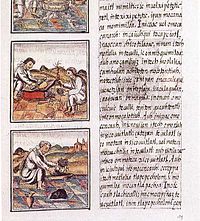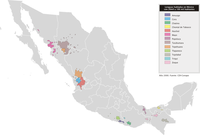Languages of Mexico
This article may require copy editing for grammar, style, cohesion, tone, or spelling. (April 2007) |
Mexico has an enormous linguistic diversity; apart from Spanish, the government recognizes 62 indigenous Amerindian languages as national languages. According to the Council for the Development of the Indigenous Peoples (CDI), 13% of the population is of Amerindian origin; nonetheless only 6% of the population speaks an Indigenous language.
| Indigenous languages of Mexico | |
| Language | Speaker |
|---|---|
| Nahuatl (Mexicano, Mexicanero, Nahuat, Nahual, Melatahtol) | 1,376,026 |
| Yucatec Maya (Maaya t'aan) | 759,000 |
| Mixtec (Tu'un sávi) | 423,216 |
| Zapotec (Binizaa) | 410,901 |
| Tzeltal Maya (K'op o winik atel) | 371,730 |
| Tzotzil Maya (Batsil k'op) | 329,937 |
| Otomí (Hñä hñü) | 239,850 |
| Totonac (Tachihuiin) | 230,930 |
| Mazatec (Ha shuta enima) | 206,559 |
| Ch'ol (Mayan) (Winik) | 185,299 |
| Huastec (Téenek) | 149,532 |
| Chinantec (Tsa jujmí) | 125,706 |
| Mixe (Ayüük) | 115,824 |
| Mazahua (Jñatho) | 111,840 |
| Tarascan (P'urhépechas) | 105,556 |
| Tlapanec (Me'phaa) | 98,573 |
| Tarahumara (Rarámuri) | 75,371 |
| Mayo (Yoreme) | 32,702 |
| Amuzgo (Tzañcue) | 43,761 |
| Chatino (Cha'cña) | 42,791 |
| Tojolab'al (Tojolwinik otik) | 43,169 |
| Popoluca (Zoquean) (Tuncápxe) | 54,004 |
| Chontal de Tabasco (Yokot t'an) | 43,850 |
| Huichol (Wixárika) | 35,724 |
| Mayo (Yoreme) | 32,702 |
| Tepehuán (O'odham) | 31,681 |
| Trique (Tinujéi) | 24,491 |
| Cora (Naáyarite) | 17,086 |
| Popoloca (Oto-manguean) | 18,926 |
| Huave (Ikoods) | 15,993 |
| Cuicatec (Nduudu yu) | 12,610 |
| Yaqui (Yoreme) | 14,162 |
| Q'anjob'al | 10,833 |
| Tepehua (Hamasipini) | 10,625 |
| Pame (Xigüe) | 9,768 |
| Mam (Qyool) | 8,739 |
| Chontal de Oaxaca (Slijuala sihanuk) | 5,534 |
| Chuj | 2,143 |
| Tacuate (Mixtec de Santa María Zacatepec) (Tu'un Va'a) | 2,067 |
| Chichimeca jonaz (Úza) | 1,987 |
| Guarijío (Makurawe) | 1,905 |
| Chocho (Runixa ngiigua) | 1,078 |
| Pima Bajo (O'odham) | 836 |
| Q'eqchí (Q'eqchí) | 835 |
| Lacandón (Hach t'an) | 731 |
| Jakaltek (Poptí) (Abxubal) | 584 |
| Matlatzinca/Ocuilteco (Tlahuica) | 522 |
| Seri (Concaac) | 518 |
| Ixcatec | 406 |
| K'iche' | 286 |
| Kaqchikel | 230 |
| Paipai (Akwa'ala) | 221 |
| Cucapá (Es péi) | 206 |
| Mototzintleco (Qatok) | 186 |
| Kumiai (Ti'pai) | 185 |
| Pápago (Tohono O'odham) | 153 |
| Kikapú (Kikapooa) | 144 |
| Ixil | 108 |
| Cochimí (Laymón, mti'pá) | 96 |
| Kiliwa (Ko'lew) | 55 |
| Aguacatec | 27 |
| Other languages 1 | 337 |
| Only includes population 5 and older. Source: INEGI (2005) [1] | |
Legislation
Spanish is the predominant language of Mexico and de facto official language. Nonetheless, the second article of the 1917 Constitution defines the country as a pluricultural nation, and recognizes the right of the indigenous peoples to "preserve and enrich their languages..." and promotes "bilingual and intercultural education" [2].
In 2003 Congress approved the General Law of Linguistic Rights of Indigenous Peoples, which recognizes that Spanish and the indigenous languages of Mexico are "national languages" due to their historical background and "have the same validity in their territory, location and context". This law allows indigenous peoples to present and request official documents in their respective language. The state commits to the preservation and promotion of the use of the national languages through the activities of the National Institute of Indigenous Languages [3].
With around six million speakers of an indigenous language, Mexico has the second largest portion of speakers of Native American languages of the Americas after Peru. However in terms of percentages the population is relatively small compared to countries like Guatemala (42.8%), Peru (35%), and even Ecuador (9.4%), Panama (8.3%) [4], Paraguay and Bolivia.
Other than the Nahuatl languages, no indigenous language of Mexico has more than a million speakers. Nahuatl is among the native American languages with the largest populations along with Quechua, Aymara and Guaraní and some Mayan languages.
Process of marginalization of the indigenous languages of Mexico

A slow process of displacement of the indigenous languages began from the arrival of the Spanish and the Spanish language in Mexico. Although in the beginning of colonization efforts were made by some monks and priests to describe and classify the indigenous languages (in order to facilitate the conversion of those peoples to Christianity), the Catholic Church also served as the first instrument of replacing the indigenous languages with Spanish. Philip II of Spain had decreed in 1570 that Nahuatl should become the official language of the colonies of New Spain in order to facilitate communication between the Spanish and natives of the colonies. However, in 1696 Charles II made a counter decree banning the use of any languages other than Spanish throughout the Spanish Empire. (Cifuentes, 1998). Starting from the 1700s decrees ordering the "hispanization" of the indigenous populations became more numerous, which lead to the colonizers giving up on learning the indigenous languages.
After the independence the liberal governments began undertaking steps towards building an educational system primarily aimed at the hispanization of the native populations. The idea was that this would help the indigenous peoples become a more integrated part of the new Mexican nationality.
Other than during the Second Mexican Empire, lead by Maximilian I of Mexico, no other Mexican government had tried to prevent the loss of the indigenous language during the 19th century. [citation needed]
In 1889, Antonio García Cubas calculated the percentage of indigenous language speakers in Mexico to be 38%. This is in contrast with previously recorded figures that calculated 60% in 1820. By the end of the 20th century this had become only 6%. [citation needed]
During the 20th century the policy of successive governments and their officials was to deny any status as valid languages to native tongues. During this time indigenous students were forbidden to speak native languages in their schools and were often punished for doing so.
In 1992 the fourth article of the constitution was amended with the purpose of reinforcing the nation's pluricultural nature by giving the State the obligation of protecting and nurturing the expressions of this diversity. On June 14, 1999, the Council of Writers in Indigenous Languages presented Congress with a document titled "Suggestion of legal initiatives towards linguistic rights of indigenous peoples and communities", with the intent to begin the protection of the indigenous communities' linguistic rights. In December 2002 the Ley General de Derechos Lingüísticos de los Pueblos Indígenas was passed. This law establishes a framework for the conservation, nurturing and development of indigenous languages. This law, however, has been criticised for having complex structure which hinders its actual application (Cuevas, 2004: 13).
Classification
The following is a classification of the 62 Indigenous languages grouped by family:
Language families with members north of Mexico
Language families with all known members in Mexico
- Oto-Manguean languages:
- Oto-pamean branch: Northern Pame, Southern Pame, Chichimeca Jonaz, Otomí, Mazahua, Matlatzinca and Ocuiltec.
- Popolocan branch: Popoloca language, Chocho, Ixcatec language*, Mazatecan languages
- Tlapanec-Subtiaban branch: Me'phaa
- Amuzgoan branch: Amuzgo de Guerrero, Amuzgo de Oaxaca
- Mixtecan branch: Mixtecan languages, Cuicatec and Trique language.
- Chatino-Zapoteca family: Chatino (and its dialects), Zapotec languages.
- Chinantec branch: Chinantec (and its dialects)
- Chiapaneca-mangue branch: Chiapaneco*
- Mixe-Zoquean languages:
- Zoque languages
- Mixe languages
- Popoluca (Texistepec Popoluca, Sierra Popoluca (Both Zoquean) and Sayula Popoluca Oluta Popoluca (Both Mixean))
Language family with members south of Mexico
- Mayan languages:
- Huastecan branch: Wastek language,
- Yucatecan branch: Yukatek Maya, Lacandón,
- Cholan branch: Ch'ol language, Chontal Maya language, Tzeltal language, Tzotzil language,
- Qanjobalan-Chujean branch: Chuj language, Tojolabal language, Q'anjob'al language, Jakaltek, Motozintlec, Akatek language
- Quichean-Mamean branch: Mam language, Tektitek language, Ixil, , K'iche' language, Kaqchikel and Q'eqchi'.
- Seri language
- Tequistlatecan languages: Lowland Chontal, Highland Chontal
- P'urhépecha
- Huave
*In danger of extinction.
Other languages
The "pluricultural" composition of Mexico, according to the Constitution, has its roots in the indigenous peoples. However, apart from Spanish, the government does not recognize any other non-indigenous language spoken by immigrants and their descendants, even if the number of speakers is greater than that of some of the 62 national languages. Historically, Mexican laws curbed the public usage of foreign languages in mass media (radio and TV), public road signs, business storefronts and advertising billboards. Mexicans found it ironic on the increasing usage and social toleration of Spanish being widely spoken in Mexican-American/Latino communities in the border towns and across the southwest US.
Some of the non-indigenous languages spoken in Mexico are: English (by English-speaking immigrants, as well as by the residents of border states), For example, the American Mormon colony of Nueva Casas Grandes of Chihuahua settled in the late 1800s serves as a testimonial to the country's Anglo-Americans who favored living in Mexico. Also German (mainly in Mexico City and Puebla), Arabic, Russian, Venetian (in Chipilo), French, Catalan, Basque, Galician, Asturian, Chinese, Korean, Ladino, Plautdietsch, Armenian and others in smaller numbers. Of these, Venetian, French, and Plautdietsch, among others, are spoken in isolated communities or villages, while the rest are spoken by immigrants or their descendants that tend to live in the larger cities and towns. Many of these languages are superior in number of speakers compared to those of indigenous speakers in the nation such as German dialects, Italian dialects, and French dialects compared to many native dialects in Mexico, but they are not protected by law.
See Also
References
- Cifuentes, Bárbara (1998): Letras sobre voces. Multilingüismo a través de la historia. Centro de Investigaciones y Estudios Superiores en Antropología Social - Instituto Nacional Indigenista. Historia de los Pueblos Indígenas de México. México. ISBN 968-496-338-6
- Cuevas, Susana (2004): Ley de Derechos Lingüísticos en México. En http://www.linguapax.org/congres04/pdf/4_cuevas.pdf. Accessed in August 2006.
- The corresponding article (Lenguas de México) on the Spanish Wikipedia (revision as of August 11, 2006).
External links
- CDI
- "¿Qué lengua hablas?", a portal that contains multimedia files of phrases spoken in some of the national indigenous languages.
- Ethnologue report for Mexico



